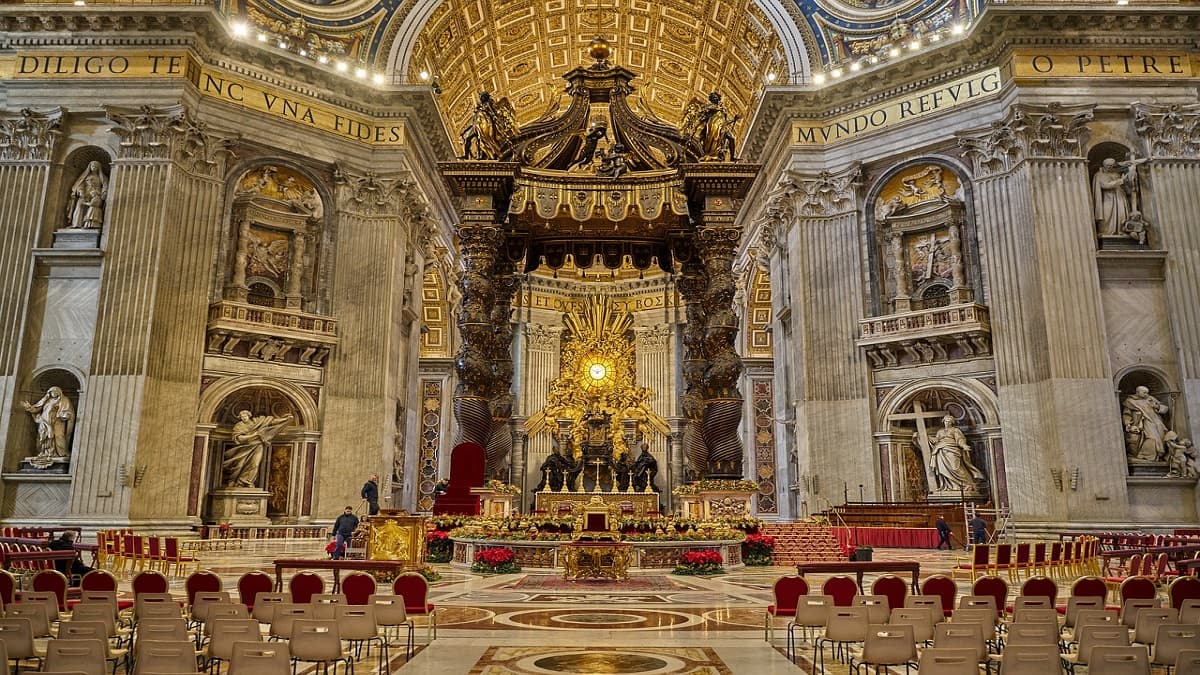Baroque Restyling of an Ancient Sacral Symbol
Baldacchino is a term that dates back to the Middle Ages that indicates a richly decorated structure created to protect people or important objects. The word "baldacco," however, referred to Baghdad, the production center of precious fabrics.
For centuries in the Christian liturgical repertoire, the altar was protected by a prestigious structure, the ciborium, made up of four columns with a covering or canopy. Gian Lorenzo Bernini, master of the Roman Baroque, merged the two elements, creating a sophisticated "hybrid" for the papal altar of Saint Peter’s.
Gian Lorenzo Bernini’s Masterpiece
The baldacchino was inaugurated on June 29th, 1633 (Feast of Saints Peter and Paul). It is in gilded bronze, is 28.75 meters high, and weighs 61,000 kg. Its ascending rhythm confers dynamism and vivacity to the metal; it rises on Solomonic columns, that is, helical or spiral columns, similar to those that embellished the early Christian basilica of Constantine.
Positioned to the west, it is illuminated during the day by various sources of light of different intensities and positions—both natural and artificial—that create refined visual and pictorial effects.
Symbolism in the Decorations
On its summit, angels support the symbols of the patrons of Rome: the keys and the tiara (St. Peter), the book, representing preaching, and the sword, representing the power of faith but also an instrument of martyrdom (St. Paul). Inside on the ceiling, the dove of the Holy Spirit spreads its wings.
A large number of golden bees are also present. When Cardinal Maffeo Barberini was elected pope with the name of Urban VIII, he chose the bee for his coat of arms, as in the Christian tradition it alludes to industriousness and charity. The laurel and the sun’s rays are also emblems of the Barberini family. In classical culture, laurel was associated with victory, and in early Christian art, it alluded to eternal life.
Dense vegetation covers the structure: ivy, pine cones, roses, and finally olive branches, symbolizing peace and the Passion of Christ. Radiant animals fight demonic forces: the lizard—turning to the sun as the faithful turn to Christ—is eating a scorpion. A fly, a symbol of evil, looks on from below, and a rosary protects all creatures.
Eight Faces in Sequence, Representing a Pregnancy and Birth
Almost hidden within the Papal coat of arms there are several marble bas-reliefs where carved heads can be made out: it is a sequence that seems to reproduce movement, similar to what would have happened centuries later in the creation of cinema. The sequence represents a woman in labor, and on the eighth bas-relief a new born baby is represented. An unusual scene that alludes to the Church as Mater, or Mother.
What the Barbarians did not do, the Barberini did!” is not a true Statement
Recent studies have thrown light upon the belief – made popular by the satirical lampoon left on the statue of Pasquino – that Pope Urban VIII nonchalantly dismantled the bronze of the Pantheon, pride of the Roman civitas, to give visibility and glory to his family: that bronze was necessary for the papal foundries for various purposes, and only a part of it was given to Bernini.

Vox City, The Vox Group's Dedicated Business-To-Consumer Arm For The Past Five Years, Is Staffed By Veteran Travel Industry Experts With A Combined 21 Years Of Expertise In The Tourism Industry. Let's Explore The Beauty Of Travel In Your Own Way At Your Own Pace.
Vox City International 63 Holly Walk | CV32 4JG Leamington Spa
2025 Vox City, All rights reserved.





